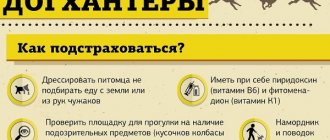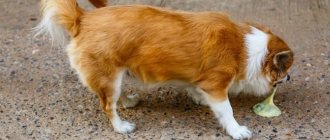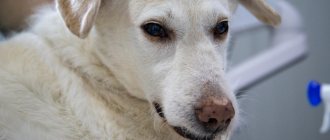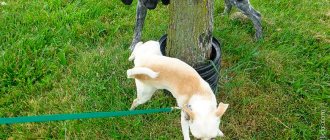A sudden deterioration in the health of a beloved pet is a serious cause for concern. Particularly dangerous is a change in the color of discharge: urine, feces and vomit. If your dog is vomiting yellow foam, ask your veterinarian what to do to normalize the condition. Vomiting is only a symptom, not an independent disease. To find out the true cause, the animal will have to undergo diagnostics at a veterinary clinic.
Why does vomit turn yellow?
The walls of the stomach are covered with mucus, which protects against the aggressive effects of gastric juice. The air swallowed by the dog penetrates inside and enters into a chemical reaction with the mucus. The result is a clear or pale yellow foam. Its light color is given by gastric juice, and the more intense shade of yellow is due to mixing with bile. It is produced by hepatocytes - liver cells. Normally, this fluid accumulates in the gallbladder and small intestine, but under the influence of certain physiological and pathological reasons it penetrates into the stomach.
First aid
If a dog vomits yellow foam, not every owner knows what to do. If the contents of the vomit contain an admixture of bile, the owner needs to establish the causes of this symptom. If your pet suffers from diseases of viral or infectious origin, then only a visit to the clinic can save his life. There is no problem in one situation: when the episode of nausea was a one-time episode, and then the dog continues to eat with appetite, behaves actively and radiates fun.
If your pet’s behavior changes, he loses interest in food and refuses to play, and bouts of vomiting recur, you should immediately consult a veterinarian . Before leaving, you shouldn’t feed your dog, but you can give him Smecta. Vomiting is not a disease, but only a symptom. It is impossible to independently help an animal sick with, for example, hepatitis.
If attacks of vomiting are systematically repeated every few weeks, this may indicate that the owners need to change the feeding regimen or type of food. Animals whose diet is based on concentrated feed more often suffer from gastritis compared to those pets that eat natural food.
Replacing concentrated foods with more natural ones will help to avoid problems with the functioning of the digestive system. Introducing fermented milk products into your pet’s diet and switching to fractional meals will help reduce the frequency of morning vomiting attacks.
Possible causes of discomfort
If you notice vomiting of bile in your dog, observe the frequency of vomiting. With one-time nausea and the absence of accompanying symptoms, the likelihood of a physiological cause is high. If the attacks do not stop, and the animal’s condition rapidly worsens, go to the veterinarian.
Dangerous (if repeated vomiting)
If your pet not only feels sick, but also has diarrhea and is bothered by a fever, then the deterioration of his condition is due to internal problems. Repeated attacks lead to severe dehydration, which is especially dangerous for puppies.
Possible pathologies include:
- Poisoning
. Acute intoxication can be caused by poison, spoiled food, or ordinary foods from the human table included in the prohibited list (confectionery, smoked meats, pickles).
- Helminthiasis
. Along with the vomit, some of the helminths come out, so large individuals can be detected without laboratory analysis.
- Infectious and blood parasitic diseases
. Your pet may be infected with infectious hepatitis, parvovirus enteritis, leptospirosis or piroplasmosis. In severe cases of the disease, blood clots come out along with yellow mucus and foam.
- Malignant neoplasms
. The growth of a tumor in the gall bladder or liver is accompanied by a decrease in activity and rapid weight loss while maintaining appetite.
- Stomach and intestinal ulcers
. The pet vomits bile mixed with undigested pieces of food, and is also tormented by foul-smelling belching.
- Liver pathologies
(liver failure, cholecystitis)
and kidneys
(renal failure, hepatitis). There is a refusal to feed, frequent belching and bloating. Jaundice, yellow-green diarrhea, or an ammonia-like odor from the mouth may occur. - Stomach diseases
(gastroenteritis, gastritis)
and pancreas
(pancreatitis). There is increased salivation, abdominal pain, weight loss, dullness and hair loss. - Intestinal obstruction
. It is caused by stuck foreign objects, an enlarged uterus, or the insertion of one part of the intestine into another (intussusception). Due to impaired blood circulation, tissue necrosis (death) is possible. Nausea occurs along with an increase in body temperature.
Also, the release of bile can be explained by prolonged drug treatment. Only a veterinarian can determine the exact cause, so do not delay your visit to the clinic and do not try to solve the problem yourself.
Non-hazardous (with single vomiting)
If your four-legged pet vomits once, and within a day he looks completely healthy, don’t worry. This may be explained by:
- Foreign object in the stomach
. Swallowed hairballs, stones, pieces of toys or bones do not always cause intestinal obstruction. To remove them, the dog actively chews grass while walking. If you notice this behavior, do not scold your pet and allow the stuck objects to come out naturally.
- Experienced stress
. Traveling on public transport, moving, or meeting a new family member are exciting events that can cause a slight stomach upset.
- Overheating
. Avoid staying in a closed car for too long or walking too long in the hot sun. If there is severe overheating, the animal may experience heatstroke, accompanied by a strong increase in temperature and muscle cramps. Hairless breeds are at risk.
- Hunger
. If you feed the animal too rarely, its gastric juice will accumulate in larger quantities. Try to shorten the interval between feedings.
- Food intolerance
. Due to artificial additives, many products cause a mild form of poisoning in animals, preventing normal digestion. What distinguishes intolerance from allergies is the longer onset of the reaction and the lack of response from the immune system.
- Overeating
. When consuming food granules that are too small, the dog feels full late. The body has to get rid of excess on its own. With low water intake, the feed will be dissolved using the liquid contained in the intestines. This can lead to serious complications, so try to ensure adequate water intake when dry feeding.
To normalize the animal’s condition, try changing the food or diversifying the diet with fermented milk products. If there is no improvement and your health worsens, sign up for an examination at the veterinary clinic.
If a prompt visit to the veterinarian is not possible
To provide first aid to a pet, you first need to ensure that the dog is calm. Remove the bowl of food for 1-2 hours. If you vomit repeatedly, do not delay visiting your doctor.
Under no circumstances should you give medications orally if you are vomiting repeatedly; the medications will not just come back out, but can also worsen the condition.
If vomiting is associated with heat stroke, you should place your pet in a cool place, wipe it with a damp cloth, and give free access to fresh water.
In cases with single vomiting, you need to change the frequency of feeding, that is, feed more often, but in smaller portions. In such situations, enveloping drugs can be used. However, the doses of the medicine must be calculated by a veterinarian, and many of them have contraindications.
In order to understand whether it is possible to give this or that medicine to your pet, you can contact Petstory therapists for an online consultation in the mobile application. You can install the application using the link.
Associated symptoms
To recognize a pathological cause, note any signs that appear. You will need to see a doctor if your dog has not only yellow vomiting, but also other alarming symptoms:
- loss of appetite and refusal to drink water, leading to weight loss;
- frequent belching, pain and rumbling in the stomach;
- the appearance of diarrhea or constipation;
- change in the color of urine to bright orange and paleness of stool to a gray tint;
- blue or yellowing of mucous membranes;
- increased temperature, increased heart rate and shortness of breath;
- dulling and matting of fur;
- frequent licking and excessive salivation;
- sudden change in mood (drowsiness and apathy are replaced by excessive affection or aggression);
- difficulty moving.
One of the most dangerous signs is hematemesis, that is, the appearance of blood in the vomit. This negatively affects the immune system and can also lead to the death of the animal due to internal bleeding.
Causes of frequent pathological vomiting in dogs
When an animal is sick, it behaves restlessly and cannot find a place. The main signs of nausea are excessive drooling, frequent licking, and smacking.
When vomiting, the dog lowers its head down, stretching its neck. At the same time, the abdominal muscles and diaphragm contract rhythmically, pushing out the contents of the stomach. If the stomach is empty, the dog may vomit foam, most often yellow in color. Vomit may vary in color, volume, consistency, and vomiting may be frequent or repeated at regular intervals. All this, with careful observation, helps to make a diagnosis faster.
The main causes of vomiting in dogs are:
- Almost all pathologies of the digestive system are gastrointestinal vomiting. Occurs as a result of frequent eating of poor quality feed. It is also one of the indicative symptoms of gastritis, gastric/duodenal ulcers, pancreatitis, hepatitis, foreign bodies, liver lipidosis, etc.
- Brain lesions (central vomiting) in which the vomiting center is constantly in a state of excitation - intracranial hypertension due to neoplasms and hydrocephalus, traumatic brain injury, meningitis, circulatory disorders, heat/sunstroke, peripheral vestibular syndrome.
- Intoxication of various origins - infectious viral or bacterial pathologies (canine distemper, parvovirus/coronavirus enteritis, pyometra, sepsis, abscesses, etc.), dysfunction of the liver, gallbladder, kidneys, parasitic infestations (worms, protozoa), drug overdose .
Severe frequent vomiting in dogs is in most cases accompanied by diarrhea, dehydration, loss of appetite, lethargy, and in severe cases, coma.
How you can help at home
In the absence of new attacks and maintaining good health, it is enough to limit yourself to a starvation diet. Leave your pet without food for half a day, making sure to provide enough water. At the end of the fast, check your reaction to a sugar cube. If nausea does not return, continue feeding as usual.
In case of repeated attacks, it is better to entrust treatment to a veterinarian. Prior to examination, avoid feeding and replace water with ice cubes. Do not try to stop nausea with antiemetic drugs: they can blur the symptoms or worsen the patient's condition. To alleviate the condition, you can give your pet activated carbon or Enterosgel, which absorbs toxins.
If a visit to the clinic is not possible in the near future, try to prevent dehydration on your own. Prepare an isotonic solution by mixing water with salt and sugar, and feed it to the animal until you receive medical help. Intravenous Ringer's solution or 5% glucose solution are also suitable.
After removing a tick from your pet, drop everything and go for an examination, even if you are outside the city limits. If treatment is late, the dog’s chance of recovery is reduced to 5%.
Mechanism of development of vomiting
If a dog is on a “starvation” diet for a long time, changes have occurred in the body that affect digestion and the processes of bile secretion. The release of bile does not occur after eating, but on an empty stomach. Most often observed in the morning on an empty stomach.
Vomiting white foam usually indicates an empty stomach. After the spasms, the pet’s condition and well-being remain quite satisfactory: the dog is cheerful, cheerful, playful, and the appetite is not impaired. If vomiting occurs no more than once a week, nothing terrible will happen.
The condition is easily treated by adjusting the diet. Your pet's daily food intake should be enriched with fatty foods. Meals are given in fractional and multiple meals. It is permissible to try giving the animal choleretic drugs, for example, corn silk.
You should be concerned if the vomiting is mixed with blood, the animal’s condition worsens, and the dog becomes lethargic and weak.
Veterinarian visit and treatment
To make a diagnosis, you will need to take blood and urine tests, as well as undergo an ultrasound and x-ray. Depending on the results, the veterinarian may order other laboratory tests to identify the pathogen and where the problem is occurring.
Depending on the cause, the four-legged patient is prescribed the following treatment options:
- Medication
. To eliminate the root cause, medications are prescribed aimed at eliminating the pathogen (anthelmintics, antibiotics, antivirals). Additionally, symptomatic treatment is carried out to eliminate the consequences of the disease and normalize the functioning of internal organs.
- Surgical
. If the intestines are blocked or an intestinal loop is compressed, the animal undergoes surgery. The surgeon removes the stuck object, cuts out tumors, eliminates suppuration and dead tissue.
After treatment, the weakened body will need strength to recover. The work of immune cells is stimulated by taking vitamin complexes, and beneficial intestinal microflora is restored with the help of probiotics.
The usual diet is introduced gradually to avoid excessive stress on the stomach. The therapeutic diet involves fractional meals of easily digestible food. The dog is given chicken broth and rice water. Gradually, watery porridge, small pieces of boiled chicken and cottage cheese are added to the diet. All food must be fresh and warm. If you don’t have time to cook, buy medicinal wet food.
The dog is vomiting foam - what to do?
It is important in this situation to determine the cause of vomiting. At the veterinary clinic, the pet will undergo the necessary tests and an x-ray of the abdominal cavity. The results will make it possible to determine the cause of the disease.
If you cannot quickly get help from a veterinarian, you should take some measures.
If you suspect poisoning from certain foods, then they should be excluded from the diet. In case of any poisoning, the dog should not be fed, but only given to lick ice cubes or given small portions of boiled water.
The animal should not be given any medications. The only exceptions are activated carbon, enterosgel, smecta or other adsorbents.
If after a daily fast and cleansing the body, vomiting has stopped, then you can gradually return to a normal diet. You should start with a small amount of chicken broth, boiled rice and buckwheat. You can then add pureed white meat chicken or turkey breast. You need to feed your pet five to six times a day. It is recommended to give your pet a decoction of flax seeds and peppermint leaves. The serving size should be increased gradually.
To prevent vomiting and various diseases, it is important to monitor the nutrition and upbringing of your pet.











